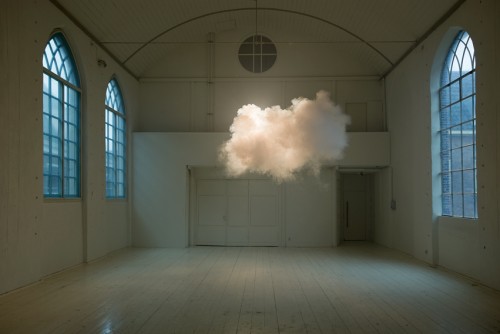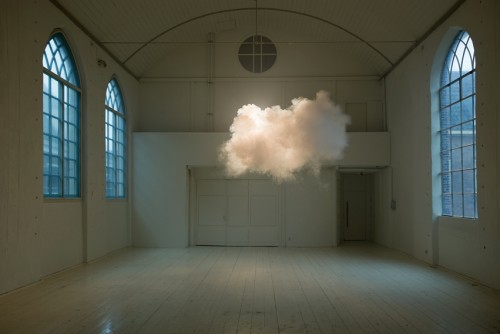
BERNDNAUT SMILDE – Nimbus II, 2012
This indoor cloud experiment was created by the 34-year-old Dutch artist Smilde in the Hotel MariaKapel, a 15th century chapel presentation space just north of Amsterdam. Combining art and science, this piece blurs the boundaries between sculpture, photography and installation.
Smilde created this indoor cloud effect by carefully manipulating and monitoring the temperature and humidity of the space, and then spraying a short burst from a fog machine, creating this puff of cloud that is briefly suspended in the space. One of the most striking things about the work is its definitive ethereality – the image you see above is a document. The effect only lasts for a matter of moments before it is gone. ‘I’m interested in the ephemeral aspect of the work… It’s about the potential of the idea, but in the end it will never function.’
The experiment was originally conducted by the artist in 2010 for an online gallery space, Probe, but on a smaller scale. In that case, the effect was documented from nine different perspectives to display online, emphasising the sculptural quality of the work – the viewer is made to feel as if they can wander around the cloud. And indeed there are many aspects of the work that would seem to define it as sculpture: it is the focal point of this space, it existed as a physical presence, not only that but it existed in a gallery – an indoor, traditional space. However, the fact that the effect is so brief, so intangible, and that the work can now only be experienced through its document – using photography – would suggest that it was more of an installation, or even a work of performance art. In this blurring of definitions, we might compare Nimbus II to the work of Richard Long.

In works such as ‘A Line Made By Walking’ (1960), Long retrospectively exhibited photographic documents of an art ‘event’ to which the only witness was himself.
But there are other possible references here. The work quite clearly alludes to Surrealism, to Dali and the whimsical images of Magritte, for example ‘La Corde Sensible’ (1960).

There is an undeniable humour in the Smilde’s image of a raincloud hanging over the room, accentuated by backlighting to ominous but comical effect. The artist explains that he wanted ‘to make a very clear image, an almost cliche and cartoon-like visualization of having bad luck.’
Smilde has also suggested the possibility of interpreting references to Dutch landscape, re-imagined in an indoor setting. It is this indoor setting which really throws the work into the realm of the surreal, but by adding a practical element – for the briefest of seconds, Smilde has translated the surreal into reality – he throws the viewer and displaces them, even through the filter of photography.
In this fascinating work, Smilde has brought into question some of the fundamental expectations of space, medium and the idea of presence itself.


Leave a Reply